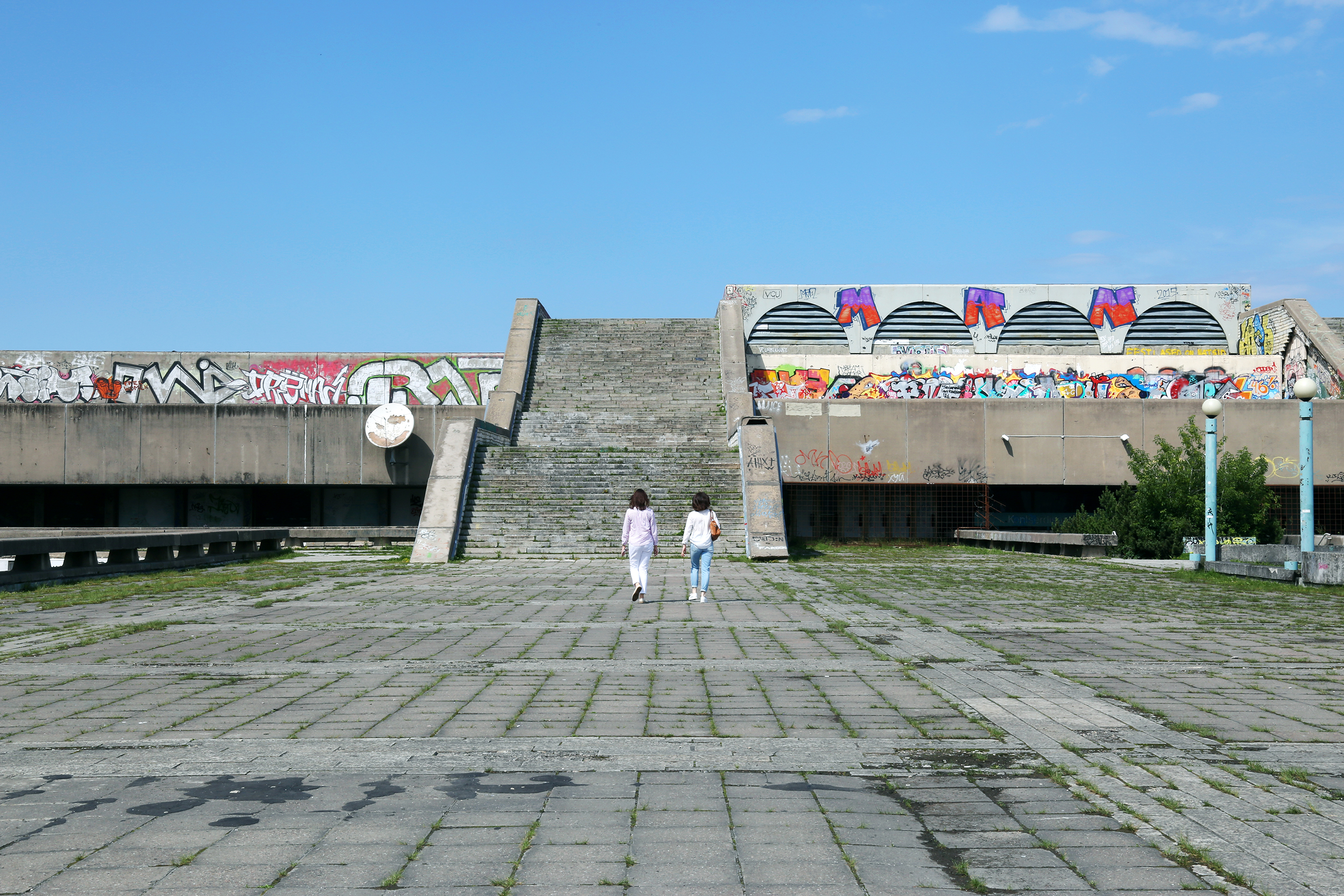Beyond the Horizon
- VIRGINIE LAGANIÈRE
-Gallery I-
Virginie Laganière
Beyond the Horizon
Beyond the Horizon continues a cycle that artist Virginie Laganière started several years ago in which she looks at modernist spaces built during eras of totalitarian regimes. Le Vaisseau/Solid Void (2013) presented at the Darling Foundry addressed Soviet architecture, while Le Prisme (2018) at OPTICA Center for Contemporary Art focused on the architecture of maritime buildings and sanatoriums that Italian fascism took over. Following prospective stays in Tallinn, the capital of Estonia, the artist now is presenting research results that refine her personal stance as an artist-researcher, through a series that uses various artistic strategies. She explores issues that relate to history yet remain anchored in the present.
Based on research, Laganière’s practice lies at the intersection of cultural studies, sociology and anthropology. Her works present narratives constructed at the convergence of documentary and fictional approaches. One of the artist’s characteristics is her use of in situ methodology. Surveys in the field nurture her artistic production; participation in artist residencies act as creative incubators. Through photography, video and sound, she captures moments in places steeped in history, while offering an updated gaze at daily life. She adopts a position that recalls the thought of the Franco-Swiss architecture historian, Bernard Tschumi, who claimed in a work published in 1996, that architecture is devoid of neutrality.[1] The author maintains that architectural images, published in magazines, often show buildings as passive objects instead of presenting them as places that confront space and action. He furthers this thought by stating “that there is no space without event, no architecture without a program.”[2]
A vibrant city, Tallinn has a complex cultural and historical past that still resonates today. One way among others that this is demonstrated is through an agenda of propagandist architecture dating from the Soviet era (1940-1991). Beyond the Horizon presents a corpus of works about two architectural sites built during the Soviet era in Tallinn, both facing major challenges in regard to their future. The Linnahall, originally called the Palace of Culture and Sports VI Lenin, is a massive structure that architect Raine Karp, assisted by Riina Altmäe, built between 1976 and 1980. The building hosted yachting and other regatta sports during the Moscow Olympic Games in 1980. Having a very solemn appearance, the Linnahall included a 4,600-seat amphitheater, an ice rink, a bowling alley, a cafeteria, a huge roof serving as a terrace and a large public square. The second site, the Maarjamäe Memorial Park (1975) was erected to commemorate, among other things, the memory of the Soviet soldiers killed during the Nazi advance in 1941. It was designed by architect Allan Murdmaa and sculptor Matti Varik. These two architectural sites are emblematic of the brutalist movement in architecture,[3] linked to late Modernism.
The presentation conceived for the exhibition space at CIRCA brings together three-dimensional elements, printed images, a central video and sound piece. The installation consists in reflecting on the future of Soviet material heritage and, implicitly, on its significance in current social affairs. These gigantic concrete shapes illustrate the greatness of the regime, a sign of the Soviet Empire’s power and strength. While some photographs of aerial views present semi-abstract images in degraded hues, the video documents scenes of everyday life around the sites, accompanied by ambient music composed from synthesizers and sound from field recordings. The composition of sound and images lead towards a speculative imagination. Laganière puts forward a reflection on the consequences, the uses and the transformation of Soviet architectural heritage. She thus documents various types of memories, including those that are forgotten.
Laganière’s images and soundtrack embody a temporal oscillation. These post-Soviet architectural constructions, traces of a bygone era, nowadays embody the physical remnants of a social project’s outcome while tending to eradicate the stigma of a heavily repressive past. Nevertheless, these constructions have survived. Currently, the post-communist generation, the young Estonians who are filmed in Laganière’s video, is facing a society in full transition in which many uncertainties are set out, such as the quest for identity. Engrossed in the electronic universe of screens, can the domestic use of technology by these protagonists make it possible to better apprehend, even to understand and absorb the various historical strata which coexist in Estonia?
Text by Esther Bourdages
Translation by Jennifer Macklem
[1] TSCHUMI, Bernard. Architecture and Disjunction. Cambridge, Massachusetts; London, England: The MIT Press, 1996, p. 141.
[2] Idem, p. 139.
[3] Architecture historians have debated the codification and classification of brutalist architecture, developed mainly between the 1950s and 1970s, which showcases large, massive, symmetrical forms with the use of raw concrete. The Soviet regime’s choice of this authoritarian style corresponds to the totalitarian spirit of the time.
Artist Biography
In an anthropological approach, Virginie Laganière’s research focuses on the transformations that shape our constructed, natural and technological world along with speculations about the future and the social psyche within her protean artistic installations. Her investigations, rooted in contemporaneity, reveal various strategies for dealing with the uncertainties of our time. She holds a master’s degree in visual and media arts from UQAM, and her works have been exhibited in Canada and internationally. In July 2020, she will participate in a residency in La Becque (Switzerland) with Jean-Maxime Dufresne.
Author Biography
Esther Bourdages works in the visual arts milieu as a writer and an independent curator. She holds a master’s degree in art history from the University of Montreal, concerning Swiss sculptor Jean Tinguely. Her field of interest is sculpture in the broader sense (art in-situ, installation) in relation to sound art and technology. Under the name Esther B., she plays the turntable, (man) handles vinyl records, and records soundscapes.












